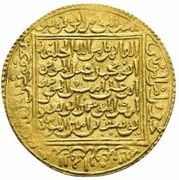Items Almohad Caliphate
Do you want to take a photo with the camera or select an existing image?
(en) Islamic state (in Arabic, ad-dawlah al-islamīyah) is a kind of government (monarchy, republic or democracy) based on Islamic religious law. The Caliphate is a form of monarchic government headed by the Caliph (in Arabic, khalīfa) who is the regent, acting as successor of Muhammad. Second in command after the Caliph, with political and military roles, is the Emir (in Arabic, amīr) literally a "commander". Another sovereign title used by numerous Arab and non-Arab dynasties is the Sultan (in Arabic, sulṭān, "strength", "authority") supreme head of Sunni Islam and ruler in the Ottoman Empire. Arab Bedouin, led by the Prophet Muhammad, starting from 7th century with the Islamic expansion, conquered a huge territory, divulgating or converting different peoples, and continued until the 18th century thanks to the Ottoman and Mughal Empires. After Muhammad's death, the first Caliphate was established. During this first Caliphate, called the Rashidun Caliphate (in Arabic, Khilāfat al-Rāshidūn "Caliphate of the Orthodox") that spanned from 632 to 661, the Umma was governed by the four chosen Caliphs: Abū Bakr, marUmar ibn al-Khattāb, ʿUthmān b. ʿAffān and ʿAlī b. Abi Tālib. The "Orthodox" Caliphate was replaced by the Umayyad Caliphate (661-750) which was governed by the Umayyad dynasty (in Arabic, al-'Umawiyyūn or Banū'Umayya "Sons of Umayya"), coming from Mecca. After toppling the Umayyad Caliphate in the Abbasid revolution, the Abbasid Caliphate (in Arabic, ʿAbbāsiyyūn) was established and lasted from 750 to 1258. The culmination of the Abbasid power was under Hārūn al-Rashīd. His life and fabulous court have been the subject of many anecdotes; the famous tale "One Thousand and One Nights" contains many stories inspired by the myth of his magnificent court. The Fatimid Caliphate (in Arabic, Fāṭimiyyūn) constituted, between 909 and 1171, the most important Ismaili Shiite dynasty in the whole history of Islam and owes its name to the descent from Fātima bt. Muhammad, daughter of the prophet Muhammad. In the mid-11th century, the Seljuks won over the Fatimids in Syria and the loss of Palestine followed, after the Crusades and Saladin's victory in Egypt, marking the end of the Arab empire and the beginning of the new Ayyubid dynasty. After the destruction of the Abbasid Empire by the Mughal Dynasty, the Ottoman Empire came to power. In 1453, it conquered Constantinople, renamed it Istanbul and made it the capital of the empire. Today there are about 1.1 billion Muslims and, not only being Arab, Islam is represented in many major cultures in over 60 countries.
Dinar (1121-1269)
AV Dinar - AR Dirham (⁷⁄₁₀) - AE Fals (¹⁄₆₀)
k. A. (1130-1260)
Münzen › Standard-Umlaufmünze
0,13 g • 8 × 8 mm
Hohertz# 645, N# 393929
k. A. (1130-1163)
Münzen › Standard-Umlaufmünze
Silber • 0,38 g • 10,5 × 10,5 mm
Album Islamic# 481.1 note, N# 356997
k. A. (1130-1163)
Münzen › Standard-Umlaufmünze
Silber • 0,76 g
Vives arab# 2113-2114-2116, Album Islamic# 481.1, 481.2, N# 81348
k. A. (1163-1184)
Münzen › Standard-Umlaufmünze
Silber • 0,6 g • 12 × 12 mm
N# 356704
k. A. (1130-1163)
Münzen › Standard-Umlaufmünze
Gold • 2,27 g
Album Islamic# 478, N# 81349
k. A. (1156-1163)
Münzen › Standard-Umlaufmünze
Gold • 2,28 g
Album Islamic# 482, N# 379152
k. A. (1163-1184)
Münzen › Standard-Umlaufmünze
Gold • 2,29 g • ⌀ 23 mm
N# 85707
k. A. (1121-1269)
Münzen › Standard-Umlaufmünze
Silber • 1,3 g • 14 mm
Vives arab# 2088-2089-2090-2091-2092-2093-2094-2095-2096-2097-2098, 2100-2101-2103-2104-2105-2106-2107-2109-2110, Mitch WI# 421, N# 9624
k. A. (1130-1163)
Münzen › Standard-Umlaufmünze
Silber • 1,48 g
Album Islamic# 480, Vives# 2046, N# 378790
k. A. (1130-1269)
Münzen › Standard-Umlaufmünze
Silber • 1,35 g • 18 mm
Mitch WI# 532, N# 228022
k. A. (1199-1213)
Münzen › Standard-Umlaufmünze
Gold • 4,60 g
N# 85846
k. A. (1213-1224)
Münzen › Standard-Umlaufmünze
Gold • 4,63 g • ⌀ 29 mm
Album Islamic# 486, N# 382790
k. A. (1224-1227)
Münzen › Standard-Umlaufmünze
Gold • 4,62 g • ⌀ 29 mm
Album Islamic# A487, N# 382791
k. A. (1229-1232)
Münzen › Standard-Umlaufmünze
Gold • 4,61 g • ⌀ 29 mm
Album Islamic# 487, N# 382792
k. A. (1232-1242)
Münzen › Standard-Umlaufmünze
Gold • 4,53 g • ⌀ 29 mm
Album Islamic# 489, N# 382793
k. A. (1242-1248)
Münzen › Standard-Umlaufmünze
Gold • 4,57 g • ⌀ 29 mm
Album Islamic# 490, N# 382794
k. A. (1266-1269)
Münzen › Standard-Umlaufmünze
Gold • 4,61 g • ⌀ 29 mm
Album Islamic# 494, N# 382795
k. A. (1121-1269)
Münzen › Standard-Umlaufmünze
Silber • 0,38 g • 9 × 9 mm
Vives arab# 2209, N# 356708
k. A. (1130-1269)
Münzen › Standard-Umlaufmünze
Silber • 0,6 g • 14 × 14 mm
Album Islamic# 497R, Hohertz# A633, N# 393927
Der Numista-Kurator für Münzen dieses Emittenten ist bennycunha97.
An item is missing from the catalogue? Add it yourself! (auf Englisch)









































